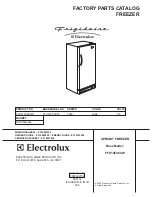
Page
13
of
16
OPERATION (cont.)
•
It is most important that the food is frozen as quickly as possible.
•
If the loading amount is too large, the quality of freezing is reduced which affects the quality of frozen foods.
•
Do not attempt if there is ¼” of ice or frost build up on the compartment walls until after the appliance has been thoroughly
defrosted and returned to its proper holding temperature.
•
Do not load food product within 4 inches of the cover.
•
Do not load more than 25-percent of the unit's storage capacity with non-frozen product. It is best if the product is pre-chilled to
50°F (10°C) before product is placed in the storage freezer.
•
Ice may be made in the unit if ice trays are placed in the baskets.
CLEANING AND MAINTENANCE
DANGER
The unit must be turned OFF and disconnected from the power source whenever performing service,
maintenance functions or cleaning the refrigerated area. Failure to comply may result in Death or
Severe Personnel Injury.
Exterior and Interior Cleaning of Appliances
Clean using soap and warm water. If this isn't sufficient, try ammonia and water or a nonabrasive liquid cleaner.
Do not use an abrasive cleaner because it will scratch the plastic and can damage the breaker strips and gaskets.
Cleaning the Condenser Coil
CAUTION
Never use a high pressure water wash for this cleaning procedure as water can damage the electrical
components located near or at the condenser coil.
Regular cleaning is recommended every 90 days. In some instances, you may find that there is a large amount of debris and dust or grease
accumulated prior to the 90 day time frame. In these cases the condenser coil should be cleaned every 30 days.
If the buildup on the coil consists of only light dust and debris, the condenser coil can be cleaned with a simple brush. Heavier dust build-
up may require a vacuum or even compressed air to blow through the condenser coil.
If heavy grease is present, there are de-greasing agents available for refrigeration use and specifically for the condenser coils. The
condenser coil may require cleaning with the de-greasing agent and then blown through with compressed air.
Failure to maintain a clean condenser coil can initially cause high temperatures and excessive run times. Continuous operation with dirty or
clogged condenser coils can result in compressor failures. Neglecting the condenser coil cleaning procedures will void any warranties
associated with the compressor or cost to replace the compressor.
•
For efficient operation, keep the condenser surface free of dust, dirt, and lint.
•
We recommend cleaning the condenser coil at least once per month.
•
Clean the condenser with a commercial condenser coil cleaner and a soft brush, available from any commercial refrigeration
equipment retailer, or vacuuming the condenser with a shop vac or use CO
2
.
Gasket Maintenance
Gaskets require regular cleaning to prevent mold and mildew build up and also to keep the elasticity of the gasket. Gasket cleaning
can be done with the use of warm soapy water. Avoid full strength cleaning products on gaskets. Do not use sharp tools or knives to
scrape or clean the gasket.
Gaskets can easily be replaced and don’t require the use of tools or authorized service technicians. The gaskets are "Dart" style and
can be pulled out of the grove in the lid and replaced by pressing the new one back into place.


































